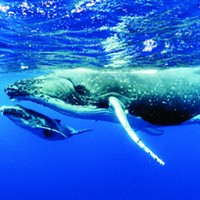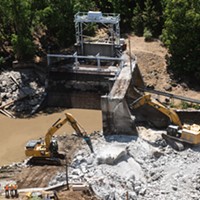Monday, August 22, 2011
Whale, CSI
Posted By Carrie Peyton Dahlberg on Mon, Aug 22, 2011 at 4:35 PM
It probably will be at least two months before marine mammal specialists get enough lab results to make an educated guess about what killed the whale that circled for so many weeks in the Klamath River.
One set of tests will look for toxins produced by freshwater algae. Another batch will assess blubber for contaminants that can build up from lubricants, insecticides, flame retardants and other chemicals in runoff. Samples from internal organs will be studied for signs of cellular abnormalities caused by anything from cancer to bacteria.
As specialists hunt for a cause of death, they’ll also be gathering material for at least two research studies, and storing away samples that could be used in others, said Denise Greig, a wildlife biologist at the Marine Mammal Center in Sausalito.
No one wants to be callous about the animal that captivated so many travelers along Highway 101. But amid the sadness, there is also opportunity.
“Fresh tissue in general is pretty much gold,” Greig said in a phone interview on Monday. “I’ve worked at the mammal center for 11 years and this is the first fresh dead whale I’ve ever seen.”
Once an animal dies, clues begin disappearing swiftly. Microorganisms such as bacteria, viruses and fungi are among the first to go, then cell structures that can point to so many causes of death, then DNA, and finally toxins held in the blubber. So the fresher the death, the greater the store of information for the future.
“We’ll have stuff archived,” Greig said, “so if somebody comes along in five years and wants a piece of gray whale blubber we can say, ‘Yes, we have some.’"
As she spoke, 6-inch-thick layers of the whale’s blubber were still curing in a preservative solution. The blubber might tell researchers not only what this whale was exposed to in ocean, but how that later changed in the river. Blubber's age can be read a little like tree rings, with the newest layers closest to the body cavity, Greig said.
The whale, which died on Aug. 15, was necropsied swiftly that same day and buried on Yurok lands. Roughly 20 people from the tribe, Humboldt State, and two marine mammal centers took photos and samples, examining everything from skin condition to the animal’s blowhole.
“We had to finish by dark and have it in the ground and buried,” said Dennis Wood, a Crescent City veterinarian, and founder of the North Coast Marine Mammal Center.
Nothing jumped out from the external examination as an obvious cause of death, Wood said, although there was one older scrape and one small wound.
Speaking of...
-

Sunken Seaweed's Dual Mission
Apr 11, 2024 -

Making Change: Love
Apr 11, 2024 -

The Klamath River Salmon Die-off Was Tragic. Was it Predictable?
Mar 8, 2024 - More »
Comments (2)
Showing 1-2 of 2
Readers also liked…
more from the author
-
Let's Bring Coast Central Out of the Shadows
- Feb 8, 2024
- More »































